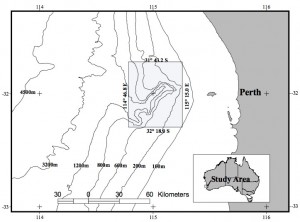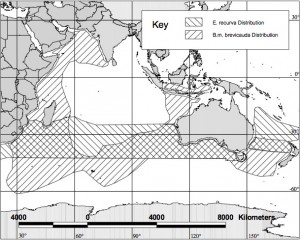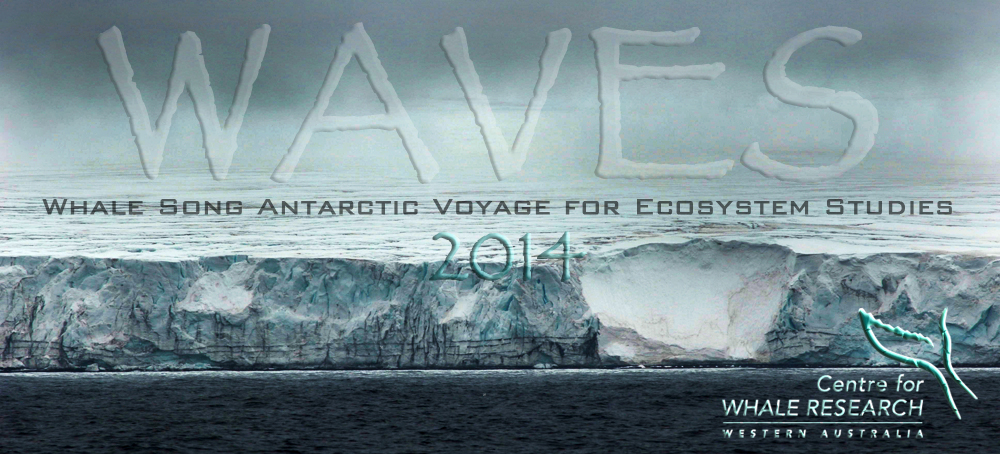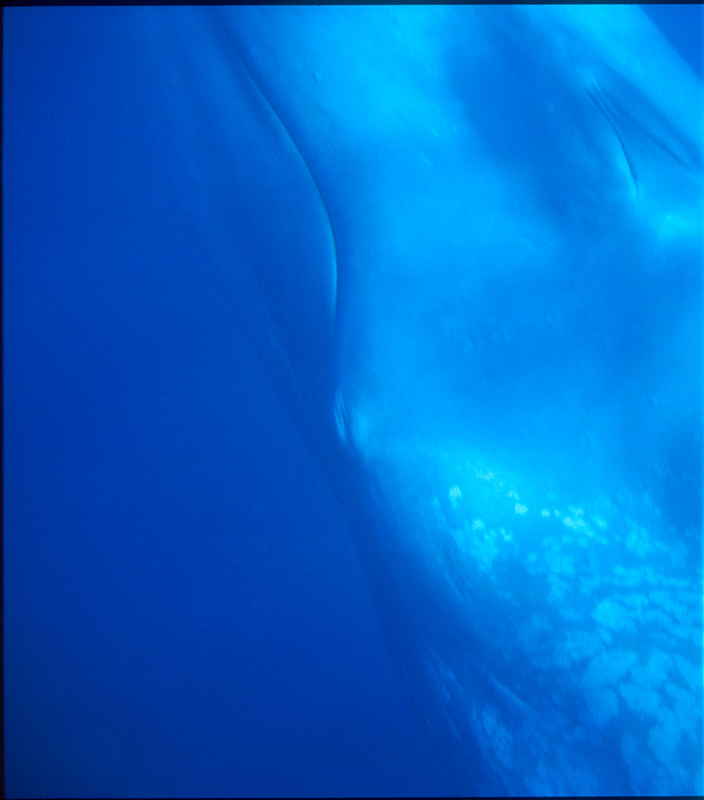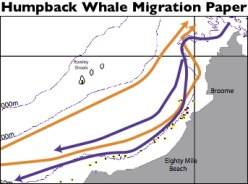Evidence Of Blue Whale Feeding In The Perth Canyon, Western Australia
K. C .S. Jenner, Wilson, S. G, Hunt, Y. M., Jenner, M-N. (2002)
Unpubl. note.
No abstract.
Download paper in PDF format (0.3mb)
K. CURT .S. JENNER, Centre for Whale Research (Western Australia) Inc., PO Box 1622, Fremantle, WA 6959, Australia; STEVEN G. WILSON, Department of Zoology, The University of Western Australia, 35 Stirling Hwy, Crawley, WA 6009, Australia; YASMIN M. HUNT, MICHELINE-N. JENNER, Centre for Whale Research (Western Australia) Inc., PO Box 1622, Fremantle, WA 6959, Australia.
In recent years, pygmy blue whales (Balaenoptera musculus brevicauda) have been observed during the summer months in Western Australian waters (Bannister 1993, Kato et al. 1996, Bannister and Burton 2000, McCauley et al. 2001). In particular, the Perth Canyon, a 2900 square km area centered at 32o 00.0’S and 115o 00.0’E, appears to be the focus of concentrations of this species for a period of several months each year (Fig. 1). Whales are frequently observed in this area swimming in large (0.5 – 1 km) circles with consistent dive patterns, leading to speculation that it is used for feeding, despite a lack of known or obvious prey aggregations at this location. However, the canyon-like bathymetry and strong surface currents in the area may be favorable at times for the upwelling of cold, nutrient-rich water which may in turn support an abundance of prey organisms (McCauley et al., 2001). Until recently, there was no direct evidence to support these hypotheses.
Between January and mid-March 2001, 75 pygmy blue whales were sighted in the Perth Canyon. Reddish-brown faecal samples, characteristic of whales that have been feeding on crustaceans (Bannister and Baker 1967), were obtained from 5 individuals during February and March. A number of live euphausiids, subsequently identified as Euphausia recurva, were collected from the footprint of a whale while dip netting sloughed skin samples. Examination of crustacean remains in the scats revealed mandibles distinctive to E. recurva. From this evidence, we conclude that pygmy blue whales aggregating in the Perth Canyon feed on E. recurva. Also present in the faecal samples were cestode worms (Tetrabohrius sp.) and large numbers of eggs, presumably from gut parasites.
The distribution of pygmy blue whales is known largely from whaling data. Between 1959 and 1972, approximately 2700 pygmy blue whales were harvested between Albany and Exmouth by Russian whalers (Zemsky and Zazhinov 1994). The distribution of E. recurva is similar to that of pygmy blue whales in the Indian Ocean (Fig. 2). E. recurva is known to be an important food source for blue, fin, humpback, sei and Bryde’s whales in South African waters (Mackintosh and Wheeler 1929, Bannister and Baker 1967, Best 1967). Sheard (1953) noted that E. recurva is the dominant euphausiid of Western Australian slope waters between latitudes 25o and 35oS (between Shark Bay and Albany), and also mentions that he captured E. recurva off Rottnest Island, Western Australia in February 1952. This species is found during daylight hours at depths of 200-500 m, vertically migrating into surface waters at night (Brinton et al. 2000). Sonar observations during daylight hours in the Canyon area are consistent with these depths, showing a distinct back scatter layer between 300 and 325 m. Therefore whales feeding on these euphausiids at depth during the day may exhibit a circling behavior to hold station over prey aggregations and conduct regular dives to systematically exploit this food source. The tendency of this species of euphausiid to be found at depth during the day may also explain the lack of surface lunge observations associated with other pygmy blue whale feeding aggregations (Gill 2000).
Whether the population of pygmy blue whales that feeds in the Perth Canyon targets this species of euphausiid specifically and exclusively throughout its range or has a more varied diet is yet to be determined. In the future, molecular analysis of scat DNA and blubber samples for the presence of fatty acids derived from various prey species may help to determine how specialized these whales are in their feeding habits.
ACKNOWLEDGMENTS
We are grateful to John Kitchener and Russell Hobbs for their taxonomic assistance. We also thank John Bannister, Rob McCauley and Chris Burton for logistical support. This work was funded by Environment Australia and the Australian Defense Department and conducted under EA permit #B2000/008.
LITERATURE CITED
BANNISTER, J. L. 1993. Whale Protection Act 1980: Summary report on activities carried out under Scientific permit P1993/030. Western Australian Museum report (unpublished) to Australian Nature Conservation Agency, Canberra, 13 pp. Available from Western Australian Museum, Francis Street, Perth WA 6000.
BANNISTER, J. L., AND C. L. K. BURTON. 2000. Investigation of blue whales off Perth, Western Australia: aerial survey, 1999-2000. Report to Environment Australia (unpublished). 10 pp. Available from Western Australian Museum, Francis Street, Perth WA 6000.
BANNISTER, J. L., AND A DE C. BAKER. 1967. Observations on food and feeding of baleen whales at Durban. Norsk Hvalfangst-Tidende 4:78-82.
BEST, P. B. 1967. Distribution and feeding habits of baleen whales off the Cape Province. Investigational Report, Division of Sea Fisheries of South Africa 57:1-44.
BRINTON, E., M. D. OHMAN, A. W. TOWNSEND, M. D. KNIGHT, AND A. L. BRIDGEMAN. 2000. Euphausiids of the World Ocean. World Biodiversity Database CD-ROM Series, Springer-Verlag, Berlin.
GILL, P. C. 2000. A blue whale feeding ground off southern Australia: preliminary findings. Paper SC/52/OS 9 (unpublished) submitted to the Scientific Committee of the IWC. 9 pp.
KATO, H., J. BANNISTER, C. BURTON, D. LJUNGBLAD, K. MATSUOKA, AND H. SHIMADA. 1996. Report on the Japan / IWC blue whale cruise 1995-96 off the southern coast of Australia. Document SC/48/SSH9 presented to the IWC Scientific Committee, Aberdeen, 35 pp.
MACKINTOSH, N. A., AND J. F. G. WHEELER. 1929. Southern blue and fin whales. Discovery Report 1:257- 540.
MCCAULEY, R. D., K. C. S. JENNER, J. L. BANNISTER, C. L. K. BURTON, D. H. CATO, AND A. DUNCAN. 2001. Blue whale calling in the Rottnest trench – 2000, Western Australia. Centre for Marine Science and Technology Report R2001-6. 57 pp. Available from Curtin University, GPO Box U 1987, Perth WA 6845.
SHEARD, K. 1953. Taxonomy, distribution and development of the Euphausiacea (Crustacea). Report of the British and New Zealand Antarctic Research Expedition, Series B (Zoology and Botany) 8:1-71.
ZEMSKY, V. A., AND E. G. SAHZINOZ. 1994. Distribution and current abundance of pygmy blue whales. Translated by Gurevich, V.S., Edited by Donahue M. A and R. L. Jr. Brownell, National Marine Fisheries Service, Southwest Fisheries Science Centre, La Jolla California, LJ-94-02.

